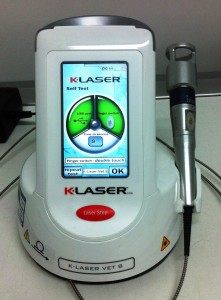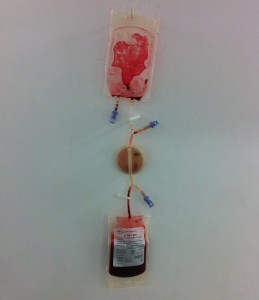At West Midlands Referrals, we see several cases of chronic degenerative joint disease (DJD) where surgical treatment like joint replacement or salvage surgery is not an option.
When conventional treatment is insufficient, two modern and emerging technologies may help. These technologies can be used alongside each other and alongside the other standard treatments (non-steroidal anti-inflammatory drugs, analgesics etc) that are described in our information sheet on DJD, which can be found in the section for owners, sub-section “fact sheets”.
One option is the class IV K-laser therapy that we have been using since 2012, which involves applying laser light energy to the affected area(s). This is done with the patient conscious, and the owner is usually present for this treatment to hold and reassure their pet. Treatment is not only completely painless, but it is very pleasant! One of our vets has had this treatment on the advice of a human physiotherapist to aid the recovery of an elbow injury. They can confirm that laser therapy is a nice sensation! Several cycles of treatment are advised, each a few days apart. The laser provides energy in the form of light. The wavelengths of the light are selected to penetrate into tissue to a depth before the energy is absorbed by the tissue. The energy absorption by the tissue results in increased local blood flow, increased local tissue oxygenation and increased metabolism and cellular energy production. Laser therapy can also have applications in wound management and in the rehabilitation of spinal patients. See our links for more information.
A second option is the injection of concentrated platelets into the affected joint(s). Platelets are present in a sample of the patient’s blood which can be easily collected from a vein. The concentrated platelet fraction is then prepared using modern filtration technology. The injection of the platelet concentrate into the joint(s) requires strict asepsis to reduce the risk of joint infection, so a short general anaesthetic is required. Clinical trials have shown that one treatment gives improved weight bearing, reduced lameness and reduced pain when measured objectively (using measuring equipment) and subjectively (when graded by owners and vets) 12 weeks after treatment. These trials were well designed: The trials were randomised and “blinded” (the people doing the measuring and assessing did not know what treatment the dogs had had and so could not be biased in their interpretations. The suggestion is that improvements in clinical signs last for months but this technology is so new that we don’t really know this yet. The idea is that platelets release platelet-derived growth factors that attract stem cells to augment repair and remodelling processes. See our links for more information.
References:
A randomized controlled trial of the efficacy of autologous platelet therapy for treating osteoarthritis in dogs. Fahie et al. J Am Vet Med Assoc 2013; 243:1291–1297
Clinical outcome using canine platelet enhancement therapy (C-PET). Fahie et al. Veterinary Orthopedic Society 39th Annual Conference 2012. Abstract reprinted in Veterinary Comparative Orthopaedics and Traumatology 3/2012, A8-9
21st Sept 2013




